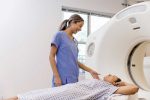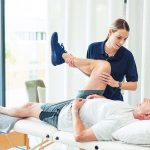Post-operative recovery following ACL reconstruction typically involves a rehabilitation program that includes a customized combination of physical therapy, exercises, and rest. The goal of rehabilitation is to regain range of motion, strength, and stability in the knee. This process can take several months and may include the use of crutches, bracing, and other assistive devices. Physical therapy is generally started within the first week or two after surgery and may continue for several months. It is important to follow your surgeon’s instructions and adhere to the rehabilitation plan to ensure the best possible outcome.
What to expect the first six weeks after ACL surgery
During the first six weeks following ACL reconstruction, the main focus of rehabilitation is on controlling pain and swelling, restoring range of motion, and beginning to regain strength in the knee. This may include the following steps:
-
Rest and icing the knee to control pain and swelling
-
Wearing a brace or other assistive device as prescribed by the surgeon
-
Gentle range of motion exercises, such as ankle pumps and knee bends
-
Gentle strengthening exercises, such as quadriceps and hamstring exercises
-
Gentle balance and proprioception exercises
It is important to follow your surgeon’s instructions and to avoid any activities that may cause pain or damage to the knee. Physical therapy sessions may be started within the first week or two after surgery and may continue for several months.
What are the recommendations after the first six weeks?
After the first six weeks following ACL reconstruction, the rehabilitation focus shifts to more intense exercises to improve muscle strength, endurance, and function of the knee. Your physical therapist will help you progress through the following steps:
-
Increasing the intensity and duration of range of motion exercises
-
Progressive strengthening exercises for quadriceps, hamstrings, calf, and core muscles
-
Closed-chain exercises, such as squats and lunges
-
Plyometric exercises, such as hopping and jumping, to improve power and coordination
- Sport-specific drills and exercises to improve function and prepare for return to sport
Avoiding any high-impact activities or twisting movements that may cause knee stress is very important during recovery. Patients can expect progress to be gradual depending on the knee’s healing process, and your therapist will monitor this closely. Depending on the individual, it may take several months to a year or more to regain full strength and function of the knee.
When should I return for follow up appointments with my surgeon?
The schedule for follow-up appointments with your surgeon after ACL reconstruction will vary depending on the individual and the surgeon’s protocols. Typically, you will have an appointment within the first 1-2 weeks following surgery to have your bandages and sutures removed and to assess your knee’s healing.
You may have follow-up appointments at 4-6 weeks, 3-4 months, 6 months and a year after surgery. At these appointments, your surgeon will assess your knee’s range of motion, strength, and stability. X-rays or MRI may also be taken to assess the healing of the graft. Your surgeon will also monitor for any signs of complications or issues with the healing process, and make adjustments to your rehabilitation plan as needed.
It’s important to attend all scheduled follow-up appointments with your surgeon to ensure that your knee is healing properly and to be confident that you are on track to regain full strength and function of the knee.



















